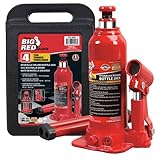Floor Jack for Lifting Cars and Trucks
A floor jacks is a practical and safe way to lift cars or trucks for flat tires and minor repairs. A floor jack usually comes with four wheels. It is for the purpose of maneuverability because most car owners find it difficult to lift and move it around, especially in the narrow spaces within a garage. It usually comes with a long handle to make it easier to slide the device underneath the vehicle. No need to get dirty sliding under the car, especially if you need to replace a flat tire on the side of the road.
The main design uses a large cylinder assembly, which contains hydraulic fluid. Another important component is the hand operated piston pump that uses the power of the hydraulic system to lift heavy objects. This is made possible by the cranking mechanism, which is operated by jacking the handle. The handle itself is connected to the release device. If you turn the handle clockwise you will close the valve but if you will turn it counter clockwise you will open the hydraulic valve.
Selecting a Floor Jack
Chose a Jack that has a weight rating to suit your car (usually 2 or 3 ton capacity jacks will suffice) and ensure it will fit under your vehicle (lowered vehicles require specialists low profile jacks)
Selecting a Floor jack that fits your needs is very important, as is getting a quality jack that will last, after all it is helping hold the car suspended above you while you work. Check out our guide here best floor jacks.
Many cars come with a scissor Jack, but we recommend for added safety that you use a floor jack whenever possible.
How to Use a Floor Jack
If changing a tire on the road prioritize safety before removing the flat tire. Before you begin, park the car properly, preferably on a flat surface, with all the wheels aligned, and then, use the emergency brake. For added safety block the wheels. When you are ready to lift the car, slide the floor or scissor jack underneath the vehicle making sure that the jack saddle is right beneath the recommended lift point. The recommended lift points are: frame rail, pinch weld, suspension arm, and rear axle.
If working on the car for prolonged periods of time such as preforming an oil change or other repairs or maintenance make sure you use Jack stands along with your garage floor Jack to ensure the car is stable and well supported else you risk being pinned down by the vehicle. When preforming repairs it’s preferable to do so on a flat concrete surface to promote stability in both the jack and the vehicle.
Failure to properly position the jack saddle can damage the sheet metal parts in the vehicle’s underbody. Once the jack saddle is in the correct place, rotate the floor jack handle clockwise to close the hydraulic valve. Pump the handle to activate the piston that will in turn use the hydraulic fluid to lift the car. Lift the vehicle slowly.
After replacing the flat tire or after completing your repairs, lower the car slowly. The first thing that you have to do is to turn the handle counter-clockwise for this will release the hydraulic valve. Always remember that floor jacks tend to be dirty or oily. Your hands may slip while operating on it. Grasp the handle tightly and turn it very slowly to prevent the vehicle from coming down rapidly.
When changing a tier, it is a good practice to bolt in the tire before you lower the vehicle. Even if the floor jack fails or the car descends rapidly due to improper handling, the car will not slam down violently because the newly inflated tire can help break the fall. Put the floor jack and jack stands away when you are done.





